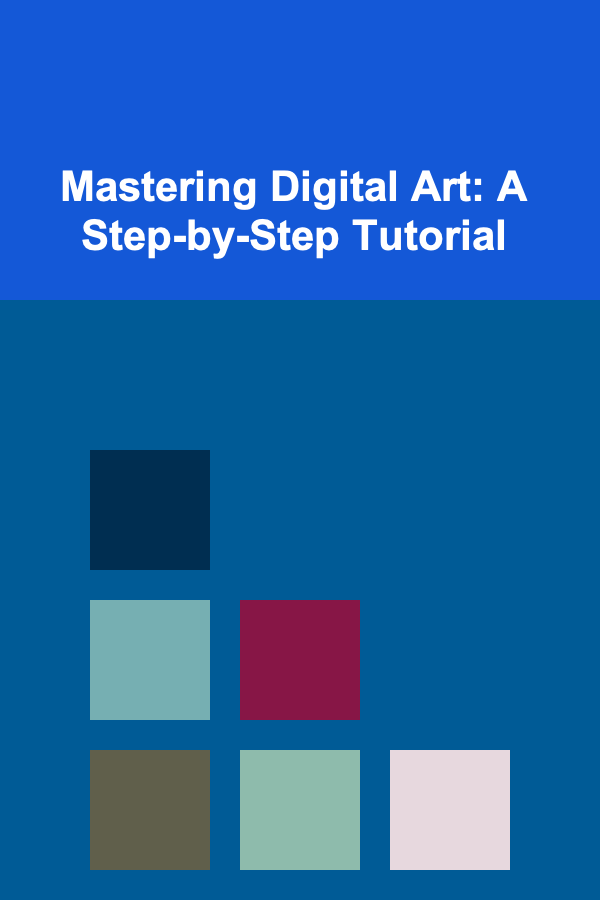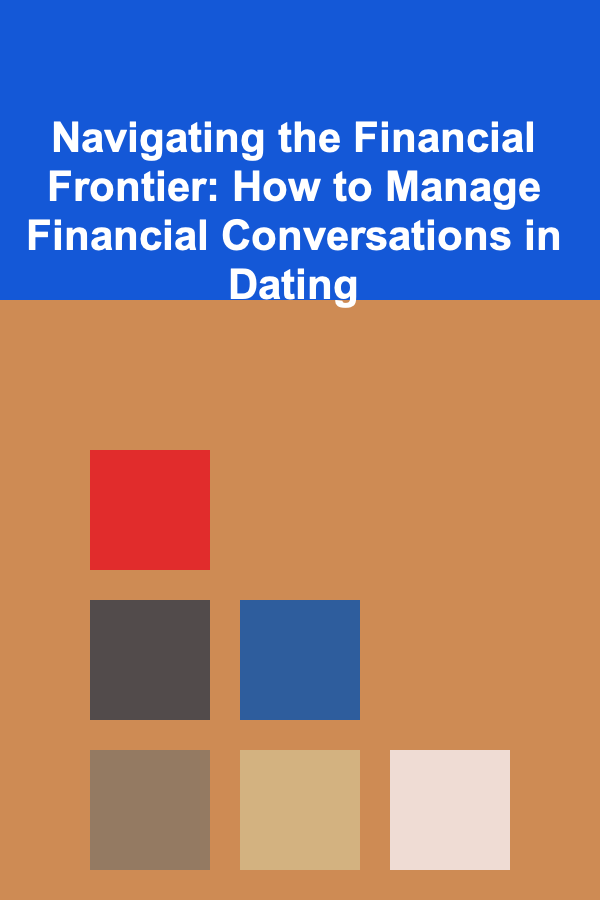
Mastering Digital Art: A Step-by-Step Tutorial
ebook include PDF & Audio bundle (Micro Guide)
$12.99$5.99
Limited Time Offer! Order within the next:

Digital art has evolved dramatically over the past few decades, becoming an essential part of the modern creative landscape. Whether you're an aspiring artist or a seasoned professional looking to branch out into digital mediums, mastering digital art offers an incredible opportunity to explore new creative avenues. With the right tools, techniques, and mindset, you can create stunning artwork that rivals traditional methods, if not surpasses them in certain aspects.
This tutorial aims to provide a comprehensive, step-by-step guide to mastering digital art. We will explore the basics of digital art creation, the essential tools and software, key techniques to develop your skills, and tips to refine your artistic process. By the end of this article, you will have a strong foundation to create your own digital art, from sketching to finalizing your masterpiece.
Understanding Digital Art
Before diving into the tools and techniques, it's important to understand what digital art is and how it differs from traditional art.
A. What is Digital Art?
Digital art refers to any artwork created using digital tools. This includes drawing, painting, and designing on a computer or tablet, as well as working with digital photography and 3D modeling. Digital art combines the flexibility of digital technology with the traditional principles of art, such as composition, color theory, and lighting. It can be created from scratch or manipulated based on existing imagery.
B. Traditional vs. Digital Art
Traditional art methods use physical materials such as pencils, paints, and canvas, while digital art relies on software and digital tools to create images on a screen. Digital art provides several advantages, such as the ability to undo mistakes, work with layers, easily adjust colors, and produce high-quality images suitable for a variety of mediums (e.g., print, web, animation). However, it also requires specific technical skills and familiarity with software interfaces, which can be daunting at first.
Choosing the Right Tools
To create digital art, you need to select the right tools. There are several key components involved in digital art creation, including hardware and software.
A. Hardware for Digital Art
The hardware you choose will play a crucial role in your digital art process. Here are the main devices to consider:
- Graphics Tablet/Tablet with Stylus: A graphics tablet allows you to draw directly on the surface, providing a more intuitive experience than using a mouse. Popular options include the Wacom Intuos and Huion Kamvas tablets. A tablet with a stylus (like the iPad Pro with Apple Pencil or a Microsoft Surface) offers similar functionality, enabling precise drawing and pressure sensitivity.
- Touchscreen Laptops: Devices such as the Microsoft Surface Pro or iPad Pro can function as both a laptop and a drawing tablet, making them portable and versatile. They allow you to draw directly on the screen, making them great for digital artists on the go.
- High-Resolution Monitor: A monitor with good color accuracy and high resolution ensures that your artwork will look sharp and vibrant. When working on a computer, consider investing in a monitor with an IPS panel for better color reproduction.
B. Software for Digital Art
Choosing the right software is essential to achieving your artistic goals. Here are some of the best digital art programs available today:
- Adobe Photoshop: Arguably the most well-known and widely used software for digital art, Photoshop is great for creating both raster (pixel-based) and vector (line-based) artwork. Its robust tools for painting, drawing, and photo manipulation make it the go-to choice for many digital artists.
- Corel Painter: Known for its realistic brush tools and textures, Corel Painter is perfect for artists who want to simulate traditional painting methods digitally. It excels in oil painting, watercolors, and other media.
- Procreate: A popular choice among iPad users, Procreate offers an intuitive interface and an extensive range of brushes and effects, making it a powerful tool for artists at all skill levels.
- Clip Studio Paint: Highly favored by comic book artists and illustrators, Clip Studio Paint is known for its ability to create clean, detailed lines and its excellent support for manga-style artwork.
- Krita: Krita is a free, open-source software that offers a range of features comparable to Photoshop and Corel Painter. It's a great option for those on a budget who want to explore digital painting.
C. Choosing Your Software
When choosing your software, consider the following factors:
- Budget: Some software, like Photoshop and Corel Painter, come with hefty price tags, while others like Krita are free. Choose the one that fits your budget and needs.
- Platform: Some programs are available on specific platforms (e.g., Procreate for iPad or Photoshop for PC/Mac). Make sure the software is compatible with your device.
- Functionality: If you're focused on painting and illustration, programs like Photoshop and Procreate are excellent choices. If you're working on comics or animations, Clip Studio Paint may be more suitable.
Getting Started: Basic Techniques
Once you've chosen your hardware and software, it's time to dive into creating your first digital artwork. Here's a step-by-step guide to getting started.
A. Setting Up Your Workspace
- Create a New Document: Open your chosen software and create a new file. Set the resolution (usually 300 dpi for print or 72 dpi for web) and choose the dimensions (inches or pixels) of your artwork.
- Customize Your Workspace: Familiarize yourself with the layout of your software. Most programs offer customizable toolbars and panels, so set up your workspace to suit your preferences.
- Organize Layers: Layers are a powerful tool in digital art. Use different layers for different parts of your artwork (e.g., background, sketch, line art, colors). This allows for non-destructive editing and easier adjustments.
B. Sketching Your Artwork
- Start with a Rough Sketch: Begin by sketching your idea using a basic brush tool. Don't worry about precision or details at this stage. The goal is to lay down the general composition and get a feel for the subject.
- Refine Your Sketch: Once you're happy with the rough layout, create a new layer on top of the sketch and refine your lines. Use a thinner brush to clean up the lines and define the details of your drawing.
C. Adding Color
- Blocking in Color: Create a new layer beneath the line art and start blocking in the basic colors of your image. Use large brushes and flat colors to cover the entire canvas.
- Shading and Highlighting: Once your base colors are in place, use a softer brush to add shading and highlights. Consider the light source in your scene, and apply shadows accordingly.
- Layer Modes: Experiment with different layer modes (such as Multiply, Overlay, or Screen) to achieve different lighting effects. This can add depth and atmosphere to your artwork.
D. Detailing and Texturing
- Add Details: Begin adding finer details, such as facial features, clothing textures, or environmental elements. Use smaller brushes and adjust the pressure for finer lines.
- Textures and Brushes: Digital art programs offer a variety of brushes that mimic traditional materials like charcoal, pencil, or paint. Use these brushes to add texture and create a more organic feel to your artwork.
- Blending: Use blending tools or brushes to smoothly transition between colors and create realistic gradients or skin tones.
E. Final Touches
- Background and Foreground: Add the background and any additional layers to complete the composition. Consider elements like depth of field, perspective, and light to enhance the overall impact.
- Adjustment Layers: Many digital art programs allow you to adjust brightness, contrast, saturation, and hue through adjustment layers. Use these to fine-tune your artwork's colors and tones.
- Sharpen and Clean Up: Finally, sharpen the image if necessary and clean up any stray lines or imperfections to ensure a polished final result.
Refining Your Skills
As with any art form, practice is key to improving your digital art skills. Here are some ways to continue developing your abilities:
A. Learn from Others
Take time to study other artists' work. Analyze their use of composition, color, and technique. Participate in online art communities, attend workshops, or seek feedback to learn new tips and tricks.
B. Experiment with Different Styles
Digital art offers endless possibilities, so don't be afraid to experiment with different styles and techniques. Try painting in a realistic style one day and a more abstract style the next. Pushing your boundaries will help you discover your unique artistic voice.
C. Challenge Yourself
Set goals and challenge yourself with specific projects. Whether it's a daily drawing challenge or creating a piece based on a specific theme, setting constraints will help you focus and grow as an artist.
D. Keep Practicing
Above all, continue practicing regularly. Even if it's just a quick sketch, the more you practice, the better you'll become. Experiment with new tools, learn new techniques, and push yourself to improve every day.
Conclusion
Mastering digital art is a rewarding journey that requires patience, practice, and persistence. By understanding the tools at your disposal, learning foundational techniques, and refining your skills through constant practice, you'll be able to create stunning works of digital art. Remember, the key to success is not just about using the right tools---it's about developing your unique creative vision and exploring the endless possibilities that digital art provides.
So grab your stylus, fire up your software, and start creating---your next masterpiece is waiting to be made!

Becoming a Successful Quality Control Manager: Essential Skills for Ensuring Excellence
Read More
How to Curate a Luxury Playlist for Organizing Motivation
Read More
How to Set Up a Family Photo Organization System
Read More
How to Use Lighting to Create a Romantic Ambience in Your Bedroom
Read More
Navigating the Financial Frontier: How to Manage Financial Conversations in Dating
Read More
How to Implement AI Pathfinding in Unreal Engine
Read MoreOther Products

Becoming a Successful Quality Control Manager: Essential Skills for Ensuring Excellence
Read More
How to Curate a Luxury Playlist for Organizing Motivation
Read More
How to Set Up a Family Photo Organization System
Read More
How to Use Lighting to Create a Romantic Ambience in Your Bedroom
Read More
Navigating the Financial Frontier: How to Manage Financial Conversations in Dating
Read More